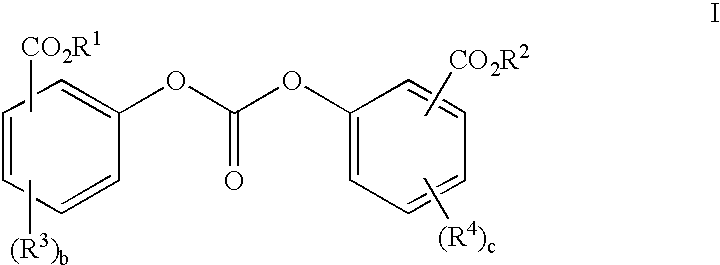Method of polycarbonate preparation
a polycarbonate and preparation method technology, applied in the field of polycarbonate preparation, can solve the problems of large equipment and capital investment, disadvantage of operating a process which requires phosgene, and operation of a process
- Summary
- Abstract
- Description
- Claims
- Application Information
AI Technical Summary
Benefits of technology
Problems solved by technology
Method used
Image
Examples
examples
The following examples are set forth to provide those of ordinary skill in the art with a detailed description of how the methods claimed herein are evaluated, and are not intended to limit the scope of what the inventors regard as their invention. Unless indicated otherwise, parts are by weight, temperature is in ° C.
General Experimental Methods
Molecular weights are reported as number average (Mn) or weight average (Mw) molecular weight and were determined by gel permeation chromatography (GPC), and, unless otherwise indicated, were determined using a polycarbonate molecular weight standard to construct a broad standard calibration curve against which polymer molecular weights were determined. The temperature of the gel permeation columns was about 25° C. and the mobile phase was chloroform.
Fries content was measured by the KOH methanolysis of resin and is reported as parts per million (ppm). The Fries content for each of the melt polycarbonates listed in Table 1 was determined as ...
examples 6-12
Polycarbonate Formation (BPA-Resorcinol)
example 6
A glass reactor equipped as described in the General Experimental Methods section which had been previously passivated by acid washing, rinsing and drying with nitrogen gas, was charged with 12.15 g of BPA, 1.46 g of resorcinol, 25.01 g of BMSC, and 100 μl of an aqueous solution of TMAH (2.5×10−4 moles per mole BPA and resorcinol combined) and NaOH (1.5×10−6 moles per mole BPA and resorcinol combined). Polymerization was carried out as described in Examples 1-3 in the following stages: Stage (1) 15 minutes (min), 180° C., atmospheric pressure, Stage (2) 45 min, 230° C., 170 mbar, Stage (3) 30 min, 270° C., 20 mbar, and Stage (4) 30 min, 300° C., 0.5-1.5 mbar. After the final reaction stage, the polymer was sampled from the reaction tube. The percent resorcinol (resorcinol is referred to here as the comonomer) incorporated into the product polycarbonate was determined by complete hydrolysis of the product polycarbonate followed by HPLC assay of the amount of resorcinol and BPA presen...
PUM
| Property | Measurement | Unit |
|---|---|---|
| temperature | aaaaa | aaaaa |
| temperature | aaaaa | aaaaa |
| temperature | aaaaa | aaaaa |
Abstract
Description
Claims
Application Information
 Login to View More
Login to View More - R&D
- Intellectual Property
- Life Sciences
- Materials
- Tech Scout
- Unparalleled Data Quality
- Higher Quality Content
- 60% Fewer Hallucinations
Browse by: Latest US Patents, China's latest patents, Technical Efficacy Thesaurus, Application Domain, Technology Topic, Popular Technical Reports.
© 2025 PatSnap. All rights reserved.Legal|Privacy policy|Modern Slavery Act Transparency Statement|Sitemap|About US| Contact US: help@patsnap.com



